Stealing Shipboard Firefighting Tactics (Eductors) for an Alternative Water Supply *UPDATED*
Stealing tactics and equipment used in shipboard firefighting, we can use the same eductor that is used to de-water shipboard firefighting water (prevents the boat from capsizing) to draft water out of a backyard swimming pool. I've done it and it works really well. Of course this eductor is considerably larger and heavier than the one shown in the video. But the output makes it a great tool to put in the box. All water tenders should have one of these.
Update: Thank's to Engineco613, a prior discussion about a commercially available water eductor called the TurboDraft can be accessed by clicking here.
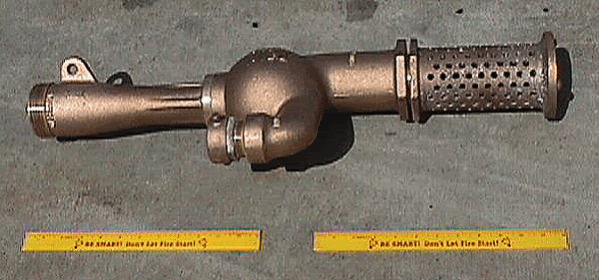
When you use the eductor to get water out of a swimming pool, you have to keep in mind that your are limited to about 200-feet maximum hose lay from the engine based on that being the standard lateral load that is used in the evolution.
Click this link to get a more descriptive step by step explanation of this new concept, (or at least I think it's new because I've never heard anyone else talk about it)... Swimming Pools and Water Eductors
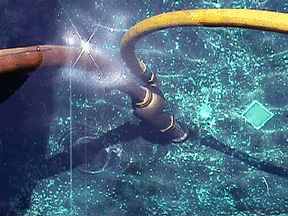
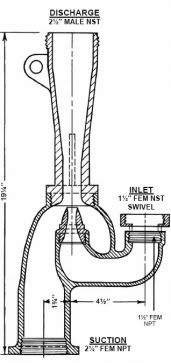
Manufacturer Suggested Uses – Fire Departments
1. Wild land Structure Protection
2. Drafting water from remote water supply
3. Dewatering basements, boats, tanks, etc.
4. Refilling Strike team
Manufacturer Suggested Uses – Marine Departments
1. Keeping bottoms dry during tank or hold washing operations.
2. Pumping water out of holds during firefighting operations.
3. Regular or emergency pumping of liquids or liquids with suspended particles from ballast, bilge, cargo spaces, pits, etc.
L.A. County Fire Department Model furnished with:
» Discharge Coupling as shown 2½” NST Male
» Inlet Coupling 1½” NST “F” swivel
» Non Return Flapper Type Check Valve
» Suction Strainer – Barrel type
S-Type Eductor Tip 000
About the 1 1/2-Inch (S-Type) Eductor
NSN 4320-00-217-0938
(Eductor, 1 1/2 In, 1 1/2 In Inlet X 2 1/2 In outlet)
Description
The 1 1/2-inch eductor is fabricated from a highly durable bronze metal and is made in the shape of an off-set half “U.” It is designed with a 1 1/2-inch NPSH swivel water inlet, a 2 1/2-inch male NH water discharge connection with a foot valve, a 2 1/2-inch suction opening at the bottom and an attached strainer.
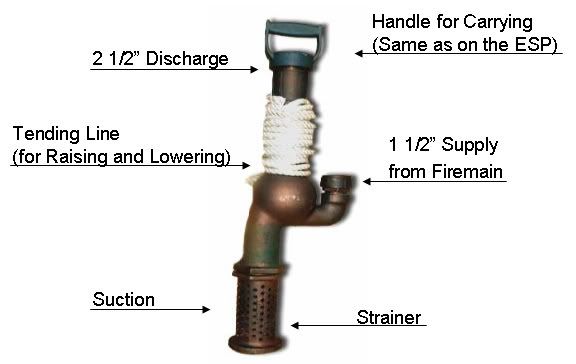
This eductor is used to pump out areas with small volumes of water. With a 100-psi, 125-gpm water supply, the eductor will pick up 100 gpm, for a net discharge of 225 gpm. It can be activated by water from the firemain, submersible pump or P-100 pump. If more than two 1 1/2-inch by 50-foot hoses are used on the actuation line, the eductor will be ineffective due to friction loss.
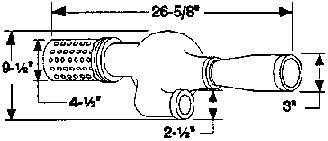
The eductor is shown with the nylon handling line. This line is used when lowering or lifting the eductor during dewatering operations. A 2 1/2-inch cap with a handle aids in carrying the eductor and protecting the male hose threads. The eductor is 26 5/8 inches long and weighs 20 pounds. It is contained in the dewatering equipment kit.
Note: The lighter and more efficient Derbyshire aluminum 1 1/2-inch eductor (NSN 9C 4320-01-110-0299) is being phased in to replace the heavier, less efficient bronze eductors.
"It's all about being able to go home in the morning..."
Mike Schlags, Fire Captain
Santa Barbara County Fire Department
mschlags@yahoo.com
Update: Thank's to Engineco613, a prior discussion about a commercially available water eductor called the TurboDraft can be accessed by clicking here.

When you use the eductor to get water out of a swimming pool, you have to keep in mind that your are limited to about 200-feet maximum hose lay from the engine based on that being the standard lateral load that is used in the evolution.
Click this link to get a more descriptive step by step explanation of this new concept, (or at least I think it's new because I've never heard anyone else talk about it)... Swimming Pools and Water Eductors


Manufacturer Suggested Uses – Fire Departments
1. Wild land Structure Protection
2. Drafting water from remote water supply
3. Dewatering basements, boats, tanks, etc.
4. Refilling Strike team
Manufacturer Suggested Uses – Marine Departments
1. Keeping bottoms dry during tank or hold washing operations.
2. Pumping water out of holds during firefighting operations.
3. Regular or emergency pumping of liquids or liquids with suspended particles from ballast, bilge, cargo spaces, pits, etc.
L.A. County Fire Department Model furnished with:
» Discharge Coupling as shown 2½” NST Male
» Inlet Coupling 1½” NST “F” swivel
» Non Return Flapper Type Check Valve
» Suction Strainer – Barrel type
S-Type Eductor Tip 000
About the 1 1/2-Inch (S-Type) Eductor
NSN 4320-00-217-0938
(Eductor, 1 1/2 In, 1 1/2 In Inlet X 2 1/2 In outlet)
Description
The 1 1/2-inch eductor is fabricated from a highly durable bronze metal and is made in the shape of an off-set half “U.” It is designed with a 1 1/2-inch NPSH swivel water inlet, a 2 1/2-inch male NH water discharge connection with a foot valve, a 2 1/2-inch suction opening at the bottom and an attached strainer.

This eductor is used to pump out areas with small volumes of water. With a 100-psi, 125-gpm water supply, the eductor will pick up 100 gpm, for a net discharge of 225 gpm. It can be activated by water from the firemain, submersible pump or P-100 pump. If more than two 1 1/2-inch by 50-foot hoses are used on the actuation line, the eductor will be ineffective due to friction loss.

The eductor is shown with the nylon handling line. This line is used when lowering or lifting the eductor during dewatering operations. A 2 1/2-inch cap with a handle aids in carrying the eductor and protecting the male hose threads. The eductor is 26 5/8 inches long and weighs 20 pounds. It is contained in the dewatering equipment kit.
Note: The lighter and more efficient Derbyshire aluminum 1 1/2-inch eductor (NSN 9C 4320-01-110-0299) is being phased in to replace the heavier, less efficient bronze eductors.
"It's all about being able to go home in the morning..."
Mike Schlags, Fire Captain
Santa Barbara County Fire Department
mschlags@yahoo.com
Tags:
Replies to This Discussion
-
Permalink Reply by Joel C Kelley on September 3, 2008 at 5:45pm
-
Just a note on the Tender/Tanker issue:
Two boot firefighters walk into a house of ill repute to experience the feminine charm. One is untried, the other is a seasoned customer of the place. When they are greeted by the Madame, The more experienced of the two says, "This is my friend's first time, find him a lady that will be gentle on him!" And he walks off to find his favorite lady of the night.
Several hours later, the two leave the brothel together, having accomplished the goal of the trip. The newly initiated and highly satisfied rookie stops and gasps, "Oh no! I forgot to pay her!"
Her friend the seasoned customer, looks over and says, "So what you're saying is that she was TENDER and you forgot to TANKER!??!"
I just couldn't resist.
-
Permalink Reply by Brian Dumser on September 3, 2008 at 5:48pm
-
LMOA!!! That was o good one...LOL
-
Permalink Reply by Engineco913 on September 3, 2008 at 9:55pm
-
I think the minimum size the Turbo draft has is 4" for an outflow. Inflow is all 2 and 1/2. I am 99% posative it's 4" or 5" as an option only
-
Permalink Reply by Ben Waller on September 3, 2008 at 10:15pm
-
We East Coasters had tankers for decades before FIRESCOPE bastardized the language and then NIMS adopted that bastardization.
I'm betting that when West Coast firefighters go to a hazmat call involving a liquid-carrying vehicle spilling gasoline or acid that it's not a "Tender" rollover, either.
Our apparatus operators must have a Commercial Driver's License with a "Tanker" endorsement, too.
It's pretty sad that the South Carolina DOT and the federal DOT hazmat hauling regulations can get this terminology right and FIRESCOPE and NIMS can't.
-
Permalink Reply by Ben Waller on September 3, 2008 at 10:16pm
-
Yeah, but then we'd never have to watch a "Love Boat" re-run again, right?
-
Permalink Reply by Oldman on October 7, 2008 at 9:21am
-
I can see how that would work well in the wildland situation. Never physically saw one. We have a Turbodraft which we have used many times on many types of fires. If I can get within 300 feet of a static source, water can be supplied at over 700 gpm. It takes practice to achieve the draft without running out of tank water, but we have been pretty successful.
We have ordered a 4000 gal vacuum tanker which can pump 1000 gpm and vacuum water at the same time, so I suppose the Turbodraft will be relegated to a reserve apparatus just in case.
I was taught by an oldtimer (back when I was younger), to apply the same principle using 1 1/2" hose inside a 3"to with a fire helmet beneath it to help keep trash out of the hose.
-
Permalink Reply by BillySFCVFD on October 7, 2008 at 11:52am
-
Oldman,
Please elaborate about your last sentence. Old school techniques are valuable when high tech isn't available on scene. Thanks and TCSS
-
Permalink Reply by Oldman on October 7, 2008 at 12:20pm
-
It is basically like a jet siphon when operating two dump tanks, in that the smaller hose is placed inside the larger hose. Tank water is pumped through the 1 1/2" causing the same siphon (or venturi) effect pulling in water around the smaller hose into the larger hose. The helmet was strapped on upside down to the assembly at the fittings, in an attempt to keep the hose out of the muck. We only practiced this a couple of times but it was effective in getting water. Back then, we never worried about flow rate so I cannot tell you how much it flowed. Maybe one of these days I'll round a crew up, deploy it and figure it out.
-
Permalink Reply by BillySFCVFD on October 7, 2008 at 1:06pm
-
Ok I get it. The smaller hose is only inserted part way towards the discharge end of the larger hose so the siphon is created inside the larger hose, right?
Who's helmet do you use? The Chief's or the rookie's?
TCSS
-
Permalink Reply by Joel C Kelley on October 7, 2008 at 1:15pm
-
My first department was an unhydranted district, and we relied on water supply operations much like are described above. The device we used was called a transfer device, but was only good for moving water from one dump tank to another. As long as we kept the tankers moving, we could flow at 750 GPM indefinitely.
Notice in the photo below that the tanker is set up with two dump tanks and the transfer device is set up to move water into the tank that is drafted from. At the same time the engineer is drafting, he is running a discharge solely for the transfer device which is using Venturi to move water from tank 2 to tank 1. He has also cracked open his tank refill and recirculate to allow the tank to refill so he can leave the scene fully in service.
-
Permalink Reply by Joel C Kelley on October 7, 2008 at 1:18pm
-
Always the chief's!
-
Permalink Reply by BillySFCVFD on October 7, 2008 at 3:08pm
-
Joel,
I'm the rookie and I'll quote you on that when needed. Should work, right? TCSS
- ‹ Previous
- 1
- 2
- 3
- 4
- Next ›
Specialty Websites
Find Members Fast
Firefighting Videos
© 2025 Created by Firefighter Nation WebChief.
Powered by
![]()
Badges | Contact Firefighter Nation | Privacy Policy | Terms of Service